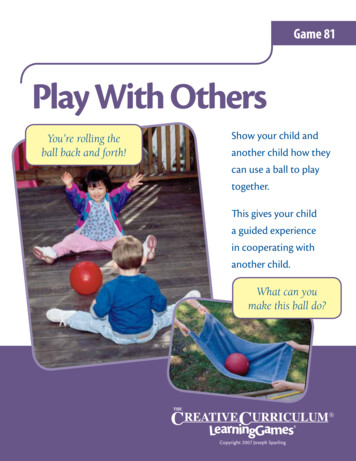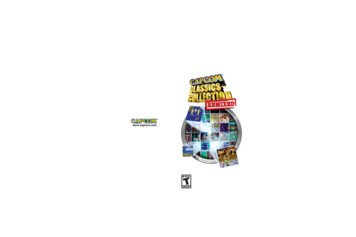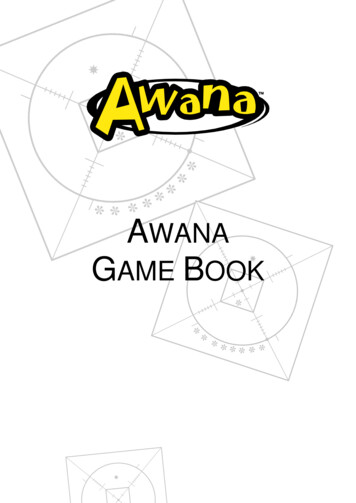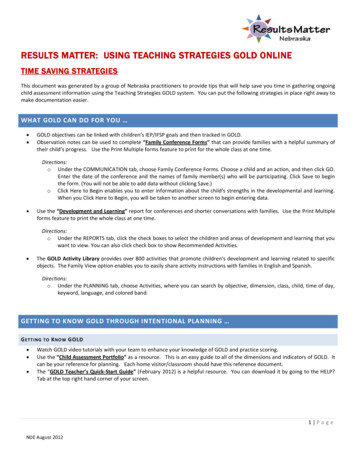
Transcription
Game 81Play With OthersYou’re rolling theball back and forth!Show your child andanother child how theycan use a ball to playtogether.This gives your childa guided experiencein cooperating withanother child.What can youmake this ball do?Copyright 2007 Joseph Sparling
Why this is importantYour child may be ready to begin learning how to play cooperatively with another child. Throughcooperative games, she will understand that playing with others can be more fun than competitionor solitary play. As she gets older, she will find that many activities can be accomplished only throughcooperative behavior. A child who enjoys cooperative games early in life is more likely to approach latersituations involving cooperation in a positive way.What you doShow your child and another how to sit on the floor so they can roll a ball back and forth. Stayclose to offer help when needed.Give them a large towel after they have had time to practice rolling the ball. Invite them to eachhold two corners of the towel.Place a light ball on the towel.Talk about how they can make the ball move. What happens if you shake the towel? What else canyou make the ball do?Use words to explain to them what they are doing. John, you’reholding up your side of the towel so the ball won’t roll off. Youcan make the ball bounce because you’re playing together.If the ball goes astray, help them get it back.Another ideaThink of other simple gamesthat two children can playtogether. Encourage them to buildwith blocks, play with toy cars, or lookat books cooperatively.Let’s read together!A Boy and His Bunnyby Sean Bryan
Game 82Choose the Doll’sClothesYou’re choosing apretty gray and whiteshirt for the girl.Let your child choose theclothes to put on a paperperson while you talk aboutand ask about the clothing.Your child can practicemaking choices aboutclothing as she learns thewords for each item.Copyright 2007 Joseph Sparling
Why this is importantYour child will learn the words for the clothing and begin to evaluate choices about what her doll shouldwear. At first, she may confuse shirts with pants or put them on the wrong parts of the doll, but withpractice she will soon understand and begin to say their names. Talking about clothes during the gamewill help your child become more aware of her own clothing and encourage her interest in dressingherself.What you doCut out a large paper person and a few simple clothes that will fit over it.Invite your child to talk about what clothes the doll might wear.Help her choose clothing by asking questions and naming the pieces for her. I see shoes, pants, acoat, and a shirt. What do you want to put on his feet? Can you find something for him to wear outsideso he will be warm?Encourage your child to choose the clothing items and lay them on the doll. After you namethem, ask her the name of each piece she chooses. What are those things called that you’re puttingon his feet?Another ideaLet’s read together!Sweaterby Kit AllenShow your child pictures ofchildren in a magazine or catalog.Talk about what they are wearing. Thisgirl has her warm, winter coat on. Later,ask your child to explain what the childrenin the pictures are dressed for such asbedtime, swimming, or cold weather.
Game 83Drawing AroundThingsYour line is goingaround the can.Give your child a roundplastic cup or objects ofother shapes to trace.Outlining things with hisfinger or a pencil gives yourchild practice using thesmall muscles in his handsas he learns about shapes.Copyright 2007 Joseph Sparling
Why this is importantTracing an object helps your child better understand the relationship of a representation, such as anoutline, to an object. With practice, he will become more aware of the differences between the shapeshe traces. Using a writing tool, such as a pencil or crayon, helps strengthen his fine motor control (theability to control the muscles in his hands). Fine motor control is essential to many later skills, such ascarefully turning the pages in a book and holding a pencil for writing.What you doShow your child how to hold a box or lid and trace around it with his finger.Offer him a pencil or crayon to trace around the shape.Follow the line on the paper with your finger. Invite your child to do the same as you talk aboutthe shape on the paper matching the object he traced. The lid is a circle. You made a circle on thepaper when you drew around it with the pencil.Give your child a chance to choose an object to trace. Talk about each shape he chooses.Guide his choices toward shapes with simple outlines such as blocks,cups, or plates.Another ideaLet’s read together!Black on Whiteby Tana HobanAllowing your child to searchfor new shapes on his own makeshim more aware of the shapesof objects around him. Keep manyinteresting objects handy for him tochoose from. Encourage him to trace eachnew shape and talk about the result onthe paper.
Game 84Teddy Bear wantsto push your car.Using aDifferent VoiceChange your voice when youspeak to your child.By varying your voice, youkeep her attention and showyour child ways to experimentwith the tone and volume ofher own voice.Copyright 2007 Joseph Sparling
Why this is importantLanguage depends on intonation and rhythm as well as words. One word can have several meanings,depending on the way it is said: “Yes?” (I’m listening), or “Yes” (I agree), or “Yes!” (Hooray!). Your childneeds to hear variety in order to create it in her own speech. When she plays whispering games with you,she learns how to control her voice.What you doSpeak to your child in a higher or lower voice or whisper in your child’s ear. She will pay closerattention to your words when you change your tone, and she may enjoy the novelty of the change.Get your child’s attention, make her feel special, and show your surprise or delight by changing thetone of your voice. For example, use your lowest bass voice to make her laugh, sing your words tohelp her relax, or, when she might expect you to call to her from across the room, instead, go to herand whisper.Respond to changes in your child’s voice by letting her know you understand what she is trying tosay. What a high voice! You sound excited about your truck rolling on the floor!Another ideaAn easy way to try out newvoices is to create a voice for eachcharacter in a book you read together.You can give her a chance to choose avoice, or make up new voices and usethem each time a character speaks.Let’s read together!Quiet Loudby Leslie Patricelli
Game 85Happy Face, Sad FaceThis boy looks happy.He’s smiling!Show your child pictures ofHappy!other people showing theirfeelings and give him wordsfor how they feel.Helping him noticethe feelings of othersdevelops your child’sability to understand hisown emotions.Copyright 2007 Joseph Sparling
Why this is importantSeeing feelings expressed on faces around him or in pictures will make it easier for your child to learn thewords for those feelings. As he hears other people talk about their feelings, he will begin to see that hecan use words instead of actions to express himself. Understanding that others have the same feelings hehas helps your child develop his relationships with those around him.What you doShow your child pictures of faces that clearly show an emotion. Talk about the expressions on thefaces. That girl is crying. She looks sad.Encourage him to talk about what makes the people in the pictures have those feelings. Avoid whyquestions because they are harder to answer.Ask him if he can remember an event that has made him feel happy, angry, or sad.Tell him how you feel. I feel happy. May I tell you about it?Give him words for his feelings. I see you look angry. Can you tell me what happened?Comfort him when he cannot express how he feels. He will needyour patience and love as he learns to determine what kindsof feelings he has.Another ideaTalk about the characters in hisfavorite storybooks and encouragehim to tell you what they are laughingor crying about.Let’s read together!What Shall We Do with the Boo-Hoo Baby?by Cressida Cowell
Game 86Two TogetherHere’s a boardthat you canroll a ball down.Give both your child anda friend a ball to kick orencourage them to roll a balldown a slanting board.An open-ended opportunityfor play with a peer helps yourchild learn cooperation skills.Copyright 2007 Joseph Sparling
Why this is importantWhen you give two children the chance to have open-ended play together, they can learn to cooperate.Playing with a ball offers your child the chance to practice skills while she learns to play with a peer. Yourchild will gradually learn how to cooperate first with you, then her peers, and finally larger groups.What you doGive your child a large, soft ball to play with. Show her how to kick it with her toe and encourageher to practice.Offer another ball to a child playing nearby. Let the two children play side-by-side.Create a cooperative game for the children after they have each had time to play with their ownball. Find a slanted surface for a ball to roll down, such as a long board with one end propped on abox.Show the children how to play together. One child stands at the top of the ramp and rolls the ballas the other waits at the bottom to catch it.Provide lots of encouragement as they play. Jeremy, you are waiting so patiently for Michaela to rollthe ball to you. Hooray! You caught it. Now you can give it back toMichaela so she can roll it again.Another ideaEncourage the children to comeup with new ways to use the balls orthe ramp together. Step back and allowthem to create their own game.Let’s read together!Is Your Mama a Llama?by Deborah Guarino
Game 87Choosing andStringingI’ve tied a ring on the end.Now let’s see what you can do.Collect a box of things thatyour child can string on aribbon or thick piece of yarn.Your child can practicemaking choices as she learnsto connect objects.Copyright 2007 Joseph Sparling
Why this is importantChildren develop confidence in themselves when their choices bring them satisfaction. When your childcreates a necklace completely on her own, she learns how to play independently and choose for herself.She also practices the skill of using her hands and eyes together to put objects on a string.What you doFill a box with household objects that have a big hole in them such as curtain rings, large spools, orjar rims. Make sure that the box contains safe objects that allow for independent play.Tie a curtain ring (or other large item) at the end of a ribbon and invite her to string other items on,one at a time. Hold the ribbon, if needed, as your child works.Talk about the size, color, and feel of the objects. These rings feel smooth and round. The ribbon is pinkand shiny.Help your child wear the finished product as a necklace if she would like to.Join your child in hunting for new objects to add to the box. She may notice that jar rims, cookiecutters, or stacking toy rings will work for stringing.Another ideaKeep the box available so yourchild can practice stringing whenshe wants to play again.Let’s read together!Color Zoo Board Bookby Lois Ehlert
Game 88In, Out, and AroundYou’re under.Think of some simple actions tohelp your child learn positionwords, such as in, out, and under,and use these words as he plays.Your child will learnthat words not onlyname objects butcan also tell abouttheir positions andrelationships.Your arms aregoing through.My arms arearound you.Copyright 2007 Joseph Sparling
Why this is importantUnderstanding that words can tell the positions and relationships of objects is a significant step in yourchild’s language development. Frequently using prepositions—words that show position—will help yourchild see one object in relation to another or in relation to himself. Relationships help to string words andideas together in oral and written language.What you doOffer your child a shoebox, a small object, and a large piece of paper. Play a game to show him themeaning of words such as in, out, and around.Show him how to put the object in the box and then take it out. He can put the object on top ofor under the paper, and he can wrap the paper around the object.Place a large box on the floor, so that he can become the object that is in, out of, and around thebox. Talk about each position as he plays. You are in the box. Can you climb out of the box?Use a toy that clearly has a front and a back, such as a small truck. Take turns with your childplacing a doll beside, behind, in front of, and on top of the truck. Talk about each position.Another ideaLet’s read together!Inside, Outside, Upside Downby Stan BerenstainAs you care for him and workaround your home, use wordsthat help your child understand theposition of objects. Your shirt is in thedrawer. Dump the bugs out of the cup.Wrap the towel around your shoulders.Your bear is on the table.
Game 89Giving One to EachOne cookie for each plate.Give your child just enoughnapkins, forks, or food items,and let him give one to eachOne!person or place at the table.Setting the table gives yourchild practical experiencewith matching one numberto one item.Copyright 2007 Joseph Sparling
Why this is importantChildren like helping with grown-up jobs. Setting the table provides an opportunity for children topractice one-to-one correspondence (one napkin for each plate). The one-to-one relationship is the basisof counting and other math skills.What you doAsk your child to help you set the table.Show him how to put a napkin beside one plate.Give him just enough napkins and ask him to put one beside each plate.Describe what he is doing using the word one. One for Daddy; one for Grandma; one for Michael.If he no longer has enough napkins to put one at each plate, help him find the place where he putmore than one. Explain what happened and offer encouragement. There were two napkins by thisplate. Can you put one at the last plate so each person has one napkin for dinner?Thank your child for helping you set the table.Ready tomove on?Let’s read together!One Bear, One Dogby Paul SticklandAfter you’ve done this activityseveral times with your child, trycounting the napkins and places at thetable before he starts. This will help himbecome familiar with the sounds of thenumber words. One, two, three, fournapkins. One, two, three, four plates.Can you put one napkin at eachplate, please?
Game 90A Fun PathYou’re followingthe path.Talk about your child’sactions as he goes alonga path of objects bystepping over, crawlingunder, jumping in, andclimbing on them.Your child’s physical skillsand awareness of spaceand positional words willincrease.Copyright 2007 Joseph Sparling
Why this is importantFollowing an obstacle course encourages your child’s physical development as well as his understandingof the position of his body in space. When you use the words that describe his actions as he plays, it iseasier for him to learn new vocabulary.What you doCreate a path of various obstacles for your child to move through, such as a cardboard box open atboth ends, a small stool to climb on and jump off, or a rumpled towel to step over.Use a piece of rope or a garden hose as a guide, if needed.Change the path occasionally, using new objects each time. Remember your child’s skill level andkeep the obstacles manageable.Stay close by and use position words to talk about what your child does. You’re going under thebench. You’re stepping over the paper.Be flexible, allowing your child to step off the path if he chooses. He may strictly follow thesequence or try different obstacles randomly.Another ideaInvite your child to play“Follow the Leader.” Allow him tolead you along the path as he chooseswhat to do next. You can be the leaderand show him a new way to movearound each object.Let’s read together!Jonathan and His Mommyby Irene Smalls
Encourage him to talk about what makes the people in the pictures have those feelings. Avoid why questions because they are harder to answer. Ask him if he can remember an event that has made him feel happy, angry, or sad. Tell him how you feel. I feel happy. May I tell you about it? Give him words for his feelings. I see you look angry.











